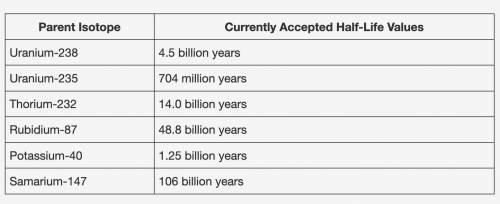
Biology, 16.10.2020 07:01, jocelynm0611
The following table shows the currently accepted half-life values for four parent isotopes.
Earth is approximately 4.5 billion years old. Given this information and the data in the table, which of the following isotopes could today contain less than 50 percent of its parent isotope?
Rubidium-87
Thorium-232
Uranium-235
Uranium-238


Answers: 2
Other questions on the subject: Biology

Biology, 21.06.2019 19:00, averylivinglife2041
One statements is an example of a scientific observation. another statement is an example of a scientific explanation. identify the correct statement for each category to illustrate how scientific explanations are inferred from scientific observations.
Answers: 3


Biology, 21.06.2019 21:00, natasniebow
Epinephrine is a hormone released from the adrenal gland of the body, most often in a stressful situation. it is known as the "fight-or-flight" hormone. one way that it causes a response in the body is to activate receptors on muscle cells. where are these cellular receptors located? a. on the cell membrane b. in the nucleus c. on the cell wall d. around the mitochondria
Answers: 1

Biology, 22.06.2019 01:30, eguilford4438
Scenario 5 1) take 10 red and 10 black beans and place them, mixed, on the table. record the starting phenotype # and frequencies (% of your total population) of your starting population in the table provided (generation 0). 2) act as a predator. “capture” as many organisms as you can until you have reduced the population to three organisms. put them aside. at this point, the predators die. 3) the remaining organisms each produce 2 clonal offspring. multiply your organisms accordingly and allow them to mix on the table. calculate and record the resultant phenotype # and frequencies (% of your total population) of your population in the table provided (generation 1). 4) repeat the reproduction event, allowing each of your organisms to produce 2 clonal offspring. calculate and record the resultant phenotype # and frequencies (% of your total population) of your population in the table provided (generation 2). 5) repeat the reproduction event, allowing each of your organisms to produce 2 clonal offspring. calculate and record the resultant phenotype # and frequencies (% of your total population) of your population in the table provided (generation 3).
Answers: 1
Do you know the correct answer?
The following table shows the currently accepted half-life values for four parent isotopes.
Earth i...
Questions in other subjects:

Mathematics, 17.07.2019 23:00



Business, 17.07.2019 23:00

Business, 17.07.2019 23:00


Social Studies, 17.07.2019 23:00


Social Studies, 17.07.2019 23:00






